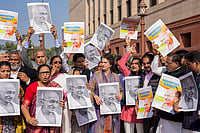Tourists clutching Elephanta guide books take the mortar and masonry of more recent times for a part of history. But the restoration efforts of Indian archaeologists have not worn well with several conservationists abroad. All the plastic bags fluttering outside the caves and the tetrapacks floating around the water cistern inside, cannot do the damage that a missive to the World Heritage Council (WHC) reporting the Archaeological Survey of India's (ASI) repairs, probably will.
In distant Norfolk, UK, Sir Bernard Feilden, director emeritus of the International Centre for the Preservation and Restoration of Cultural Property, calls it a "gross breach of conservation principles". He is appalled at the "very bad" work that Indian archaeologists have turned in. "They are creating a false ruin that deceives people," says Feilden, who feels that the ASI should have sought the approval of the WHC before undertaking restoration work.
Feilden, who last visited the caves in December 1995, has reported the matter to the Council headquarters at Paris, in a letter which says: "There has been a fundamental change since the monument was listed." His letter suggests that the Elephanta caves, a rock monument in tribute to Lord Shiva, be de-listed. The caves, indicating close proximity to the traditions of the Gupta Age, are among 17 Indian heritage sites. Along with the Ellora and Ajanta caves in Aurangabad, they are among three heritage sites in the state of Maharashtra.
"The site is a disgrace. They have used cement which is irreversible. Cement is the enemy of historic buildings," says Feilden. His arguments have left local conservation circles fuming. "He is not aware of the process of conservation," says Lt P.L. Kamble, ASI's superintending archaeologist. "Every monument has a different character. There are monuments of rocks, bricks or mud masonry and rubble—you can't treat them the same way. Had we used stone it would have been spoilt," he says, elaborating that saline action would have destroyed the surface of the stone and the joints."
Much of the work was completed before Elephanta was placed on the world heritage list in 1988, says Kamble. Work on cave number 1, for instance, was done in the late '60s, while the 28 pillars and the facade were renovated in the mid-'80s. "Work is still in progress," says Kamble, replying to criticism that the least ASI could have done was to put up a board mentioning the repairs.
Fortunately for Indian archaeologists, though its best efforts from Angkor Vat to Ajanta have been criticised, the world has not been taking too close a look at some of the other Indian heritage places. Sights and smells that offend the eyes and insult the olfactory senses may have nudged a few more Indian sites off the heritage list.
For example, in Karnataka, Hampi, capital of the Vijaynagar Kingdom, serves as both a heritage site and homing ground for encroachers. Monuments, once a part of King Krishnadevaraya's empire, double up as shanties, and the space around does any public toilet proud. At Aurangabad in Maharashtra, the Ajanta cave paintings are deteriorating under the onslaught of a thousand tourists, who contribute daily to the high decibel of sound in the caves. Excited visitors, pulling out cameras or tif -fin boxes, are a common sight at the caves. Picnicking under the gaze of a benign Buddha may be a great memory but it is not helping the 2,000-year-old paintings. The respective state governments say it is difficult to police 40 sq km of monuments in Hampi or check thousands of tourists at Ajanta, an argument too feeble for the guardians of the world's heritage.
For all its criticism of Indian heritage management, the West falls short itself, feels Benoy Behl, who is noted for his photo-documentation of historic sites. Says Behl: "Criticising Indian restoration work at Angkor Vat in Kampuchea is politically-motivated. How about their own work? I have seen German and Polish handiwork in Vietnam. They have driven metal spokes into the brick wall of an 8th century temple to hang works of another age." According to him, "The ASI is a much-maligned institution. Actually, they are a group of people constantly doing a great deal of work with a small budget."
ANGKOR Vat and reinforced cement have not tried ASI's hand as much as red tape and a government that heritage only on postcards. Says a Bombay historian: "With a budget that cannot remove dust off Indian monuments, ASI still manages to keep them standing—an unequal battle that foreign conservationists rarely see." Taking up this line, Dr Sadashiv Gorakshkar, director of the Prince of Wales Museum, Bombay, points out: "The only place the ASI can be faulted is that they should have mentioned the repairs and when they were done."
But support back home is not universal. Conservation architect Vikas Dilawari is highly critical of the ASI and the Maharashtra Tourism Development Corporation (MTDC). "The recent intervention of the ASI reveals the shocking case of reinforced cement and concrete... gunniting cave walls and reconstruction of decayed pillars... exactly matches the existing in visual completeness." Suggesting an alternaseestive in chiselled stone blocks that resemble the original pillars, Dilawari criticises MTDC's introduction of luxury boats and a new "insensitively designed" jetty at the Elephanta site. A little blue train will take 30 passengers at a time across the 750-metre jetty to the base of the steps that run up to the caves. Dilawari calls it a classic example of tourism ruining a historic site.
"The 100-year-old jetty was getting dangerous, so we requested the government to fund a new one which has been constructed after seeking permission from the authorities," says Prithviraj Patil of MTDC.
Maharashtra tourism cannot afford to ignore the gum-chewing tourist. Of some two million tourists who visit India, 46 per cent come to Maharashtra. Argues the MTDC management: "At least 33 per cent of Maharashtra's tourists land directly in Bombay and 80 per cent of them visit Elephanta, a figure that calls for luxury launches and cement jetties."
As protagonists from Bombay to Norfolk debate the cement question, Feilden maintains that most of his fight is actually in support of Indian archaeologists. "They are a good body of people, but the government does not give them the correct support. They can't fight to save the monuments—this publicity would give them a boost." The question then is will backhanded insults actually improve the lot of the ASI, and help in preserving a few more monuments?


























